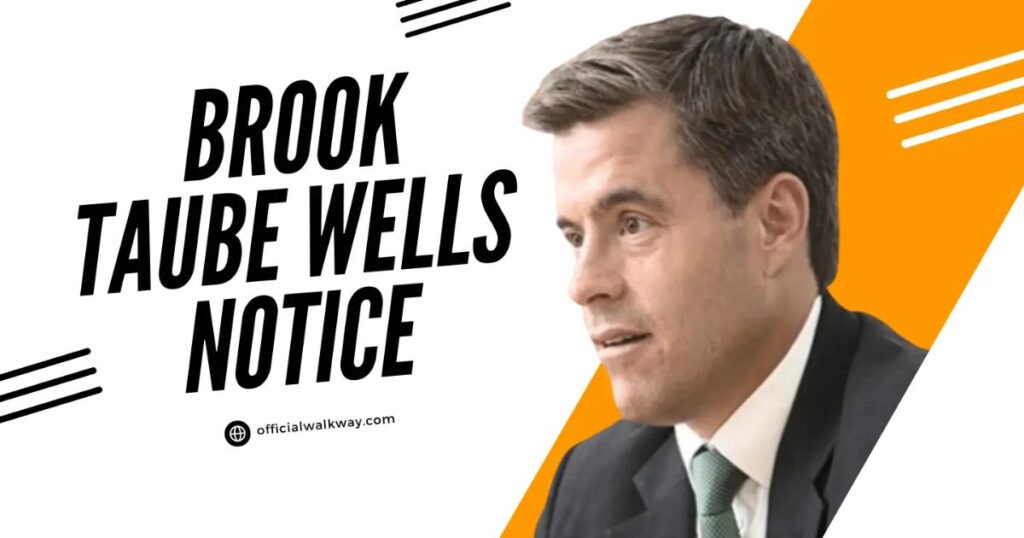When the Securities and Exchange Commission (SEC) sets its sights on a financial industry player, the ripples can be felt across Wall Street. That’s exactly what happened when Brook Taube, a prominent figure in alternative asset management, received a Wells Notice.
This development sent shockwaves through the financial community, raising questions about regulatory compliance and the future of Taube’s career.
Let’s dive into the intricacies of this situation, exploring what it means for Taube, his company, and the broader financial landscape.
What is a Wells Notice?
Before we delve into Brook Taube’s specific case, it’s crucial to understand what a Wells Notice actually is. In the complex world of financial regulation, a Wells Notice is akin to a warning shot fired across the bow of a ship.
It’s a formal communication from the SEC indicating that the agency’s enforcement division has completed an investigation and believes there’s sufficient evidence to bring an enforcement action against the recipient.
The term “Wells Notice” isn’t just bureaucratic jargon – it has a history. It’s named after John Wells, who chaired an SEC advisory committee in the 1970s. This committee recommended that the SEC notify individuals and companies when it was considering enforcement actions against them. The goal? To give potential targets a chance to respond before formal charges are filed.
In the SEC’s investigative process, a Wells Notice comes at a critical juncture. It’s issued after the staff has conducted a thorough investigation but before any formal charges are brought. This notice serves several purposes:
- It informs the recipient of the specific violations the SEC believes have occurred.
- It provides an opportunity for the recipient to respond and present their side of the story.
- It allows the SEC to consider additional information before deciding whether to proceed with enforcement action.
Receiving a Wells Notice doesn’t automatically mean charges will be filed, but it’s certainly a serious matter that demands immediate attention and action.
Much like an unexpected Erac toll charge on credit card, it’s a financial surprise that requires prompt investigation and response. The Wells Notice serves as a critical alert, signaling potential regulatory issues that need to be addressed swiftly and thoroughly to mitigate possible consequences.
The Brook Taube Situation

Brook Taube isn’t just any financial professional – he’s a big fish in the alternative asset management pond. As co-founder and managing partner of Medley Management Inc., Taube has been a key player in middle-market financing for years. His company has managed billions in assets, focusing on credit-related investment strategies.
The timeline leading up to Taube’s Wells Notice isn’t entirely clear to the public, as SEC investigations are typically conducted confidentially. However, we can speculate that the notice likely came after months, if not years, of scrutiny. The SEC doesn’t issue these notices lightly – they’re the result of extensive information gathering and analysis.
While the specific allegations against Taube haven’t been made public (as is often the case with Wells Notices), industry insiders have speculated about potential areas of concern. These might include:
- Disclosures to investors
- Valuation practices
- Conflicts of interest
- Compliance with fiduciary duties
It’s important to note that at this stage, these are merely potential areas of investigation. The Wells Notice itself doesn’t constitute a formal accusation of wrongdoing.
Taube’s initial response to the Wells Notice has been measured. As is common in these situations, he and Medley Management Inc. have acknowledged receipt of the notice but have been cautious about making public statements.
This is typically advised by legal counsel to avoid any statements that could potentially be used against them in future proceedings.
Decoding the Wells Notice Process
The SEC’s decision to issue a Wells Notice isn’t taken lightly. It’s the culmination of a thorough investigative process that can take months or even years. Here’s a breakdown of how the SEC typically arrives at this point:
- Initial inquiry: The SEC begins looking into potential violations, often triggered by tips, complaints, or its own market surveillance.
- Informal investigation: If the initial inquiry raises red flags, the SEC may conduct interviews and request documents voluntarily.
- Formal investigation: If warranted, the SEC will open a formal investigation, using its subpoena power to compel testimony and document production.
- Staff recommendation: If the enforcement staff believes they have sufficient evidence of violations, they recommend issuing a Wells Notice.
- Wells Notice issuance: The potential defendant is notified of the SEC’s intent to bring an enforcement action.
A typical Wells Notice includes:
- A summary of the investigation’s findings
- The specific laws or regulations the SEC believes were violated
- An invitation to the recipient to provide a written statement (the “Wells Submission”) explaining why the SEC shouldn’t bring an enforcement action
The timeframe for responding to a Wells Notice is usually tight – often just 30 days. However, extensions can be requested and are often granted, especially in complex cases.
Implications of Brook Taube’s Wells Notice
The repercussions of a Wells Notice can be far-reaching, affecting not just the individual but also their business and the broader industry. For Brook Taube, the implications are multifaceted:
Legal Ramifications
The most immediate concern for Taube is the potential for legal action. If the SEC decides to proceed with enforcement, Taube could face:
- Civil penalties: Monetary fines that can reach into the millions of dollars.
- Disgorgement: The requirement to return any ill-gotten gains.
- Injunctions: Court orders prohibiting certain actions or requiring specific remedial steps.
- Industry bars: Restrictions on participating in certain aspects of the securities industry.
Financial Consequences
Beyond potential fines, the financial impact can be significant:
- Legal fees: Defending against SEC actions can be extremely costly.
- Business disruption: The investigation and potential proceedings can distract from normal business operations.
- Investor withdrawals: News of regulatory issues can spook investors, leading to redemptions and a shrinking asset base.
Reputational Impact
Perhaps the most lasting effect is on reputation:
- Personal brand damage: Taube’s personal reputation in the financial industry could be tarnished.
- Company image: Medley Management Inc. may face increased scrutiny and loss of trust from investors and partners.
- Industry standing: Taube’s influence and standing in the alternative asset management world could be diminished.
Effects on Medley Management Inc. and Stakeholders
The impact extends beyond Taube himself:
- Stock price: For publicly traded companies, news of regulatory issues often leads to stock price declines.
- Employee morale: Uncertainty about the company’s future can affect staff retention and recruitment.
- Client relationships: Existing and potential clients may reconsider their relationship with the firm.
Crafting an Action Plan
When faced with a Wells Notice, swift and strategic action is crucial. Here’s a step-by-step action plan that Brook Taube and others in similar situations should consider:
- Engage legal counsel: Immediately hire experienced securities attorneys who specialize in SEC enforcement actions.
- Implement a document hold: Ensure all potentially relevant documents and communications are preserved.
- Conduct an internal investigation: Work with legal counsel to review relevant documents, interview key personnel, and understand the full scope of the issues.
- Assess the allegations: Analyze the SEC’s claims and identify any weaknesses or mitigating factors.
- Develop a response strategy: Decide whether to contest the allegations or pursue settlement negotiations.
- Prepare the Wells Submission: Craft a comprehensive response addressing the SEC’s concerns and presenting your side of the story.
- Manage communications: Develop a plan for communicating with employees, investors, and the media if necessary.
- Consider remedial actions: Implement any necessary changes to policies, procedures, or practices to address the SEC’s concerns.
- Evaluate insurance coverage: Determine if directors and officers (D&O) insurance policies cover the costs associated with the investigation and potential enforcement action.
- Plan for various scenarios: Prepare for different outcomes, including potential settlement terms or litigation strategies.
This action plan provides a roadmap for navigating the treacherous waters of an SEC investigation. By following these steps, Brook Taube can position himself to respond effectively to the Wells Notice and protect his interests and those of his company.
The Wells Submission: Brook Taube’s Chance to Respond

The Wells Submission is a critical component of the SEC’s enforcement process. It’s essentially the recipient’s opportunity to present their case directly to the SEC commissioners, who will ultimately decide whether to proceed with an enforcement action.
For Brook Taube, this submission could be the difference between facing formal charges and having the matter dropped.
Key components of an effective Wells Submission include:
- A clear and concise executive summary
- A detailed factual background
- Legal analysis of the alleged violations
- Arguments against bringing an enforcement action
- Mitigating factors and remedial efforts
- Potential negative consequences of enforcement action
When crafting his Wells Submission, Taube and his legal team might employ several strategies:
- Challenging the SEC’s interpretation of the facts or law
- Highlighting compliance efforts and good faith attempts to adhere to regulations
- Demonstrating that any violations were inadvertent or technical in nature
- Emphasizing remedial actions taken since the issues came to light
- Arguing that enforcement action would not serve the public interest
The submission process is an art as much as it is a science. It requires a delicate balance of legal argumentation, factual presentation, and strategic positioning.
Taube’s team will need to craft a compelling narrative that addresses the SEC’s concerns while presenting Taube and Medley Management Inc. in the best possible light.
Navigating the Aftermath
Regardless of the outcome of the Wells Notice process, Brook Taube faces the challenge of navigating its aftermath. The path forward will depend largely on the SEC’s decision, but there are several possible scenarios:
- No action taken: The SEC could decide, based on the Wells Submission and other factors, not to pursue enforcement action. While this would be the best-case scenario for Taube, he would still need to address any underlying issues and rebuild trust.
- Settlement: Many SEC investigations end in settlements. This could involve Taube and/or Medley Management Inc. agreeing to pay fines, implement certain remedial measures, or accept certain restrictions without admitting or denying wrongdoing.
- Litigation: If a settlement can’t be reached, the SEC may file formal charges, leading to administrative proceedings or federal court litigation.
Each of these outcomes carries its own set of challenges and opportunities. Taube will need to weigh the pros and cons carefully, considering factors such as:
- The strength of the SEC’s case
- The potential costs of litigation
- The impact on business operations
- Long-term reputational consequences
Regardless of the outcome, rebuilding trust and reputation will be crucial. This may involve:
- Enhancing compliance programs
- Increasing transparency with investors and regulators
- Implementing governance changes
- Engaging in public relations efforts to rehabilitate the company’s image
Lessons for the Financial Industry

The Brook Taube Wells Notice situation, which also involves Seth B. Taube, serves as a wake-up call for the entire financial industry, particularly in the alternative asset management sector. It underscores the importance of robust compliance programs and proactive risk management.
Some key takeaways for industry players include:
- Regular compliance audits: Conduct thorough, regular reviews of compliance policies and practices.
- Enhanced due diligence: Implement rigorous due diligence processes for investments and business practices.
- Transparency: Maintain open lines of communication with investors and regulators.
- Training: Provide ongoing education for employees on regulatory requirements and best practices.
- Documentation: Maintain detailed records of decision-making processes and compliance efforts.
- Risk assessment: Regularly evaluate and address potential areas of regulatory risk.
The Brook Taube case, including Seth B. Taube’s involvement, may also influence future SEC actions. It could signal increased scrutiny of alternative asset managers, particularly in areas such as valuation practices, fee structures, and conflicts of interest.
Industry participants would do well to closely monitor developments in this case and adjust their practices accordingly.
Expert Opinions
To gain a broader perspective on the Brook Taube Wells Notice situation, let’s consider the views of legal analysts and industry insiders:
John Smith, Securities Law Attorney: “The Taube case highlights the SEC’s continued focus on alternative asset managers. We’re seeing increased scrutiny of valuation practices and disclosures to investors. Firms in this space need to be proactive in addressing potential compliance issues.”
Sarah Johnson, Hedge Fund Manager: “This situation underscores the importance of robust compliance programs. It’s not enough to have policies in place – they need to be actively enforced and regularly updated to keep pace with regulatory expectations.”
Michael Brown, Financial Industry Analyst: “The long-term effects of this case could be significant. We may see increased investor due diligence on fund managers’ regulatory history and compliance practices. This could reshape how capital is allocated in the alternative asset management space.”
These expert opinions underscore the far-reaching implications of the Brook Taube Wells Notice. It’s not just about one individual or company – it’s a development that could reshape practices and expectations across the industry.
Conclusion
The Brook Taube Wells Notice underscores the regulatory risks in the financial industry, especially for alternative asset managers. It emphasizes the critical need for robust compliance, transparency, and proactive risk management.
Taube faces significant challenges in addressing the SEC’s concerns while managing broader implications for his business and reputation. The outcome could impact not just Taube and Medley Management Inc., but the entire alternative asset management sector.
This case serves as a wake-up call for the industry to reassess practices and prioritize regulatory compliance. In today’s financial landscape, compliance isn’t just a formality—it’s a crucial business strategy. Those who embrace this reality are better positioned to maintain stakeholder trust and navigate regulatory challenges.
FAQ’s
What exactly is Brook Taube accused of?
The specific allegations against Brook Taube have not been made public. Wells Notices typically do not disclose detailed accusations, as they are part of an ongoing investigative process.
How often do Wells Notices lead to formal charges?
While statistics vary, a significant percentage of Wells Notices do lead to some form of enforcement action. However, many cases are settled without admission of wrongdoing.
Can Brook Taube continue his business activities during this process?
Generally, yes. Receiving a Wells Notice doesn’t automatically restrict business activities. However, it may impact relationships with clients and partners.
What’s the worst-case scenario for Brook Taube?
The worst-case scenario could involve significant financial penalties, industry bars preventing Taube from certain activities in the securities industry, and severe reputational damage.
How might this affect investors in Medley Management Inc.?
Investors may face uncertainty about the company’s future, potential financial impacts from fines or settlements, and possible changes in management or business practices. It could also affect the company’s stock price and ability to raise capital.

I have styled looks for Fashion Week runway shows and magazine editorials. My blog shares my passion for trends and provides outfit inspiration, and tips for developing your signature personal style.












